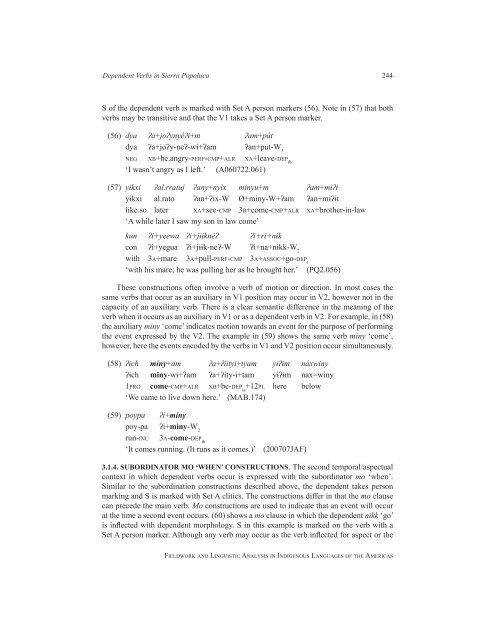Fieldwork and Linguistic Analysis in Indigenous ... - ScholarSpace
Fieldwork and Linguistic Analysis in Indigenous ... - ScholarSpace
Fieldwork and Linguistic Analysis in Indigenous ... - ScholarSpace
Create successful ePaper yourself
Turn your PDF publications into a flip-book with our unique Google optimized e-Paper software.
Dependent Verbs <strong>in</strong> Sierra Popoluca 244<br />
S of the dependent verb is marked with Set A person markers (56). Note <strong>in</strong> (57) that both<br />
verbs may be transitive <strong>and</strong> that the V1 takes a Set A person marker.<br />
(56) dya ʔa+joʔynyéʔɨ+m ʔam+pút<br />
dya ʔa+joʔy-neʔ-wɨ+ʔam ʔan+put-W 3<br />
neg xb+be.angry-Perf-cmP+alr xa+leave-deP ib<br />
‘I wasn’t angry as I left.’ (A060722.061)<br />
(57) yɨkxi ʔal.rratuj ʔany+nyíx m<strong>in</strong>yu+m ʔam+mɨʔɨ<br />
yɨkxi al.rato ʔan+ʔix-W Ø+m<strong>in</strong>y-W+ʔam ʔan+mɨʔɨt<br />
like.so later xa+see-cmP 3b+come-cmP+alr xa+brother-<strong>in</strong>-law<br />
‘A while later I saw my son <strong>in</strong> law come’<br />
kun ʔi+yeewa ʔi+jɨɨknéʔ ʔi+ri+nɨ́k<br />
con ʔi+yegua ʔi+jɨɨk-neʔ-W ʔi+na+nɨ́kk-W 2<br />
with 3a+mare 3a+pull-Perf-cmP 3a+assoc+go-deP t<br />
‘with his mare; he was pull<strong>in</strong>g her as he brought her.’ (PQ2.056)<br />
These constructions often <strong>in</strong>volve a verb of motion or direction. In most cases the<br />
same verbs that occur as an auxiliary <strong>in</strong> V1 position may occur <strong>in</strong> V2, however not <strong>in</strong> the<br />
capacity of an auxiliary verb. There is a clear semantic difference <strong>in</strong> the mean<strong>in</strong>g of the<br />
verb when it occurs as an auxiliary <strong>in</strong> V1 or as a dependent verb <strong>in</strong> V2. For example, <strong>in</strong> (58)<br />
the auxiliary m<strong>in</strong>y ‘come’ <strong>in</strong>dicates motion towards an event for the purpose of perform<strong>in</strong>g<br />
the event expressed by the V2. The example <strong>in</strong> (59) shows the same verb m<strong>in</strong>y ‘come’,<br />
however, here the events encoded by the verbs <strong>in</strong> V1 <strong>and</strong> V2 position occur simultaneously.<br />
(58) ʔɨch míny+am ʔa+ʔíityi+tyam yɨʔɨm náxw<strong>in</strong>y<br />
ʔɨch m<strong>in</strong>y-wɨ+ʔam ʔa+ʔity-i+tam yɨʔɨm nax=w<strong>in</strong>y<br />
1Pro come-cmP+alr xb+be-deP ia +12Pl here below<br />
‘We came to live down here.’ (MAB.174)<br />
(59) poypa ʔi+míny<br />
poy-pa ʔi+m<strong>in</strong>y-W 2<br />
run-<strong>in</strong>c 3a-come-deP ib<br />
‘It comes runn<strong>in</strong>g. (It runs as it comes.)’ (200707JAF)<br />
3.1.4. SUBORDINATOR MO ‘WHEN’ CONSTRUCTIONS. The second temporal/aspectual<br />
context <strong>in</strong> which dependent verbs occur is expressed with the subord<strong>in</strong>ator mo ‘when’.<br />
Similar to the subord<strong>in</strong>ation constructions described above, the dependent takes person<br />
mark<strong>in</strong>g <strong>and</strong> S is marked with Set A clitics. The constructions differ <strong>in</strong> that the mo clause<br />
can precede the ma<strong>in</strong> verb. Mo constructions are used to <strong>in</strong>dicate that an event will occur<br />
at the time a second event occurs. (60) shows a mo clause <strong>in</strong> which the dependent nɨkk ‘go’<br />
is <strong>in</strong>flected with dependent morphology. S <strong>in</strong> this example is marked on the verb with a<br />
Set A person marker. Although any verb may occur as the verb <strong>in</strong>flected for aspect or the<br />
fieldwork <strong>and</strong> l<strong>in</strong>guistic analysis <strong>in</strong> <strong>in</strong>digenous languages of the americas

















